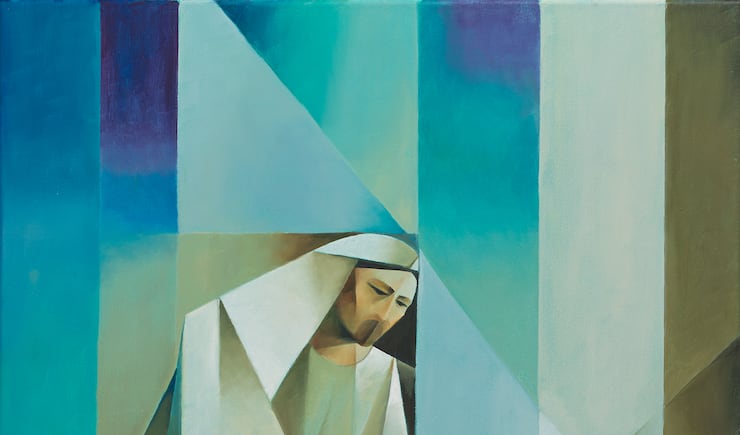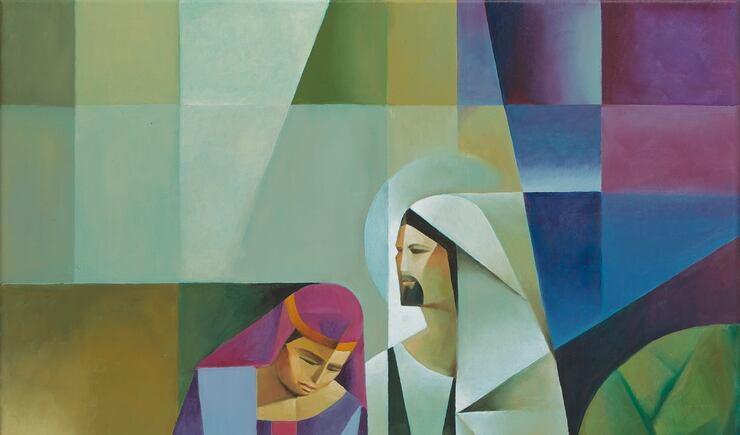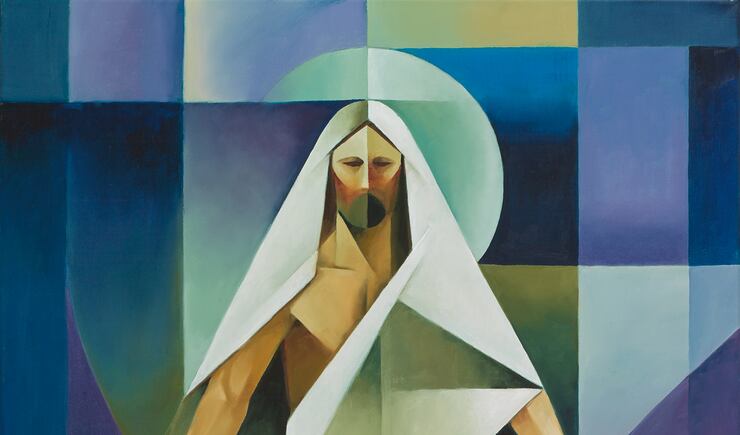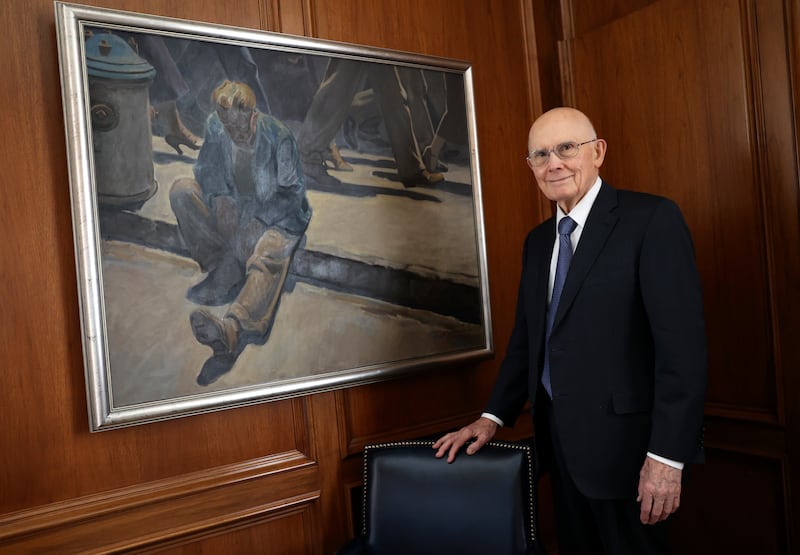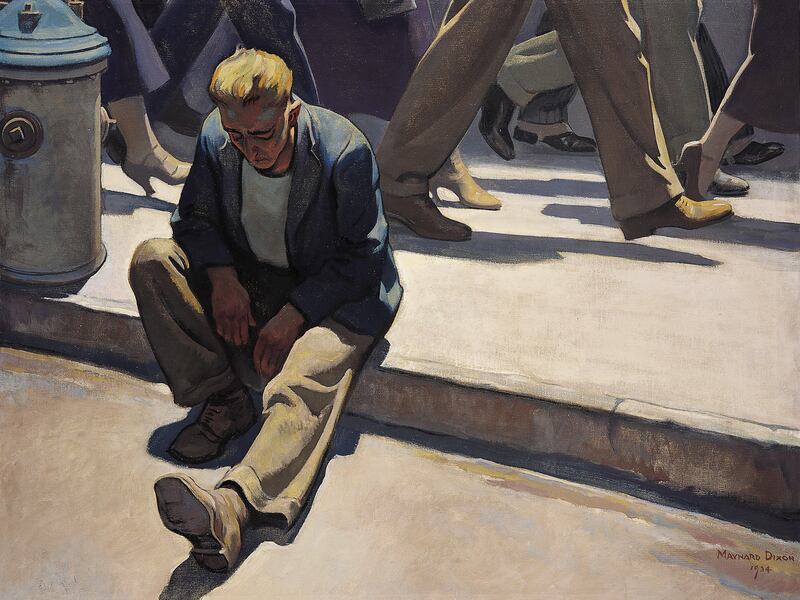This article was first published in the ChurchBeat newsletter. Sign up to receive the newsletter in your inbox each Wednesday night.
My favorite lawyers tell knee-slapping lawyer jokes. It’s a grand tradition.
Here’s a funny one:
Having just moved to a new home, a young boy meets the boy next door. “Hi, my name is Billy,” he says. “What’s yours?” “Tommy,” replies the other. “My daddy’s an accountant,” says Billy. “What does your daddy do?” “He’s a lawyer,” Tommy answers. “Honest?” asks Billy. “No, just the regular kind.”
The jokes are a great way to signal that while some attorneys fit the cultural stereotype, others — most, according to BYU’s law school dean, Gordon Smith — use it for good.
“I think some people don’t think of lawyers always as peacemakers, especially if we’re fomenting conflict to generate business, but that’s not what most lawyers do,” Smith told me on Friday.
We had started our conversation in front of the seven striking, original and new paintings by Jorge Cocco Santángelo showing Jesus Christ performing the legal roles he inhabited — healer, mediator, counselor, peacemaker, advocate, lawgiver and judge. (See all seven paintings below.)
The paintings now permanently hang on a wall outside the moot courtroom on the third floor of the J. Reuben Clark Law Building. Smith, on the other hand, walked as we talked. He gave me a tour of the paintings and pictures the law school recently has begun to put up around the building.
“Law school as art museum,” he said.
Standing momentarily in his office, which includes a both paintings and large photographed portraits of people around the world, he said the role of a lawyer is to reduce contention.
“Most of us try to resolve conflict, we try to resolve disputes, and do so in a way that allows people to walk away as peacefully as possible. The whole purpose of the legal system is to prevent violent conflict,” he said.
The goal is to use the rule of law — everyone follows a publicly created set of laws enforced equally and adjudicated independently — rather than descend into violence and chaos.
“Lawyers really are peacemakers in our society, and we want to emphasize that to the students,” Smith said.
It’s why Cocco’s image of Jesus Christ as peacemaker is the centerpiece of his seven new paintings hanging at the law school.
Cocco spoke at the unveiling. He said the burden he carries is waking up each day with more images in his mind than he ever will be able to complete. When I interviewed him afterward, I asked him what else he wanted people to know.
“I feel honored and thankful,” he said, “for the opportunity to communicate with other human beings through the gift God gave me.”
Communicating with law students through art is exactly what Smith wants to do. He has assigned one of the law school employees to oversee art in the building.
“We’re trying to communicate through art what we hope our students will aspire to become once they graduate from law school, and that is people who are serving the one persistently and making sure that nobody’s forgotten,” he said.
“It’s hard to teach. It’s harder to do.”
The idea began with a display of photographs designed to communicate the idea that every person has a value and is worthy of respect, concepts from the 2018 Punta del Este Declaration of Human Dignity for Everyone Everywhere, an international document created in part by BYU’s International Center for Law and Religion Studies.
Now a display about the declaration and photographs of people around the world adorn a wall on the law building’s second floor.
“When that went up, I had this little epiphany that we’ve got all these walls here that are instructional spaces, essentially, like an art museum,” Smith said as we peered down on that display from the third-floor lobby.
“So in our library now we have a display on women’s suffrage, and outside the trial courtroom on the level below we have a display that’s about the the civil justice system in the United States.”
Smith then walked me around a corner to view a print of the famous 1934 Maynard Dixon painting, “Forgotten Man.” The BYU Museum of Art owns the original painting. A print hangs in the office of President Dallin H. Oaks, first counselor in the First Presidency of The Church of Jesus Christ of Latter-day Saints, which sponsors BYU.
President Oaks is first vice chairman of BYU’s Board of Trustees.
Smith has spoken frequently about the reason he had a print of “Forgotten Man” installed at the law school.
“As a lawyer, our job is to go out and treat every individual with respect and convey that they are children of our Heavenly Father, that their value is great in the sight of God, and that nobody should be forgotten,” he said. “That’s our role, to make sure that nobody is forgotten.”
Smith told me the law school is talking with another well-known Latter-day Saint artist about creating another painting for the law school related to Christ’s teachings of the value of all people.
“Our hope is to drive these themes home with our students,” Smith said. “If you’re a lawyer and you have that embedded deeply within you, you’re going to be a great lawyer.”
My recent stories
Kyiv Ukraine Temple reopens to Latter-day Saints as conflict continues (Oct. 17)
Can a public university advance religious freedom? ASU President Michael Crow’s tenacious take (Oct. 17)
BYU law school unveils artist Jorge Cocco’s new paintings of Jesus Christ’s 7 law-related roles (Oct. 14)
A cyber attack breached some Latter-day Saint member data. Here’s what we know (Oct. 13)
About the church
President Russell M. Nelson offered six steps to becoming “true disciples of Jesus Christ” in a talk to western Canadian Latter-day Saints.
Elder Dieter F. Uchtdorf traveled to New Zealand. He was greeted by a Māori warrior in a welcoming ceremony. Then he rededicated the renovated Hamilton New Zealand Temple.
Elder David A. Bednar toured five European countries. Here’s an excellent report from Mary Richards about his ministry stops in Romania and Hungary.
Have you seen the photos of the church’s Hill Cumorah reforestation project?
You can download an updated chart of the church’s general authorities here.
A BYU football player’s career-ending injury led to acting. Now he’s Captain Moroni in the Book of Mormon Videos series. He’s got a great outlook on losing one dream and moving forward. Read more here.
I’ve spent both too much time and far too little time combing through the links provided in this article, which is a great survey of what it bills as “today’s most fascinating Book of Mormon research.”
What I’m reading
A Latter-day Saint father of five from Rexburg, Idaho, died in Ukraine of shrapnel wounds while acting as a volunteer fighter in an international legion defending the country.
As far as what I’m watching, I really enjoyed the first season of “The Rings of Power” on Prime Video. The two creators behind the series share the backstory of how they won the competition to make the show and respond to critics in this story.
Oh, and my daughter who loves the original Star Trek series is watching the first season of “Star Trek: Strange New Worlds” with me. It’s a terrific nod to the OG Star Trek, with the captain who preceded James T. Kirk working alongside a young Spock and young Lt. Uhura. The title says it all: It mimics the original series as in each episode the crew seeks out strange new worlds and civilizations. Here’s a rollicking review.
The Cuban Missile Crisis remains an endlessly fascinating moment in the history of the nuclear age and Cold War. I devoured this new piece by a Deseret News colleague about a little-known man at the center of the discovery that pushed the world to the brink of nuclear war.
A trio of BYU researchers say that American courts appear willing to open legal marriage to polyamory.
Behind the scenes
